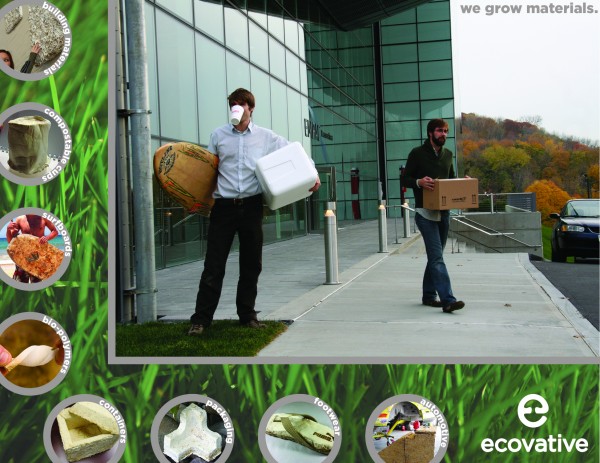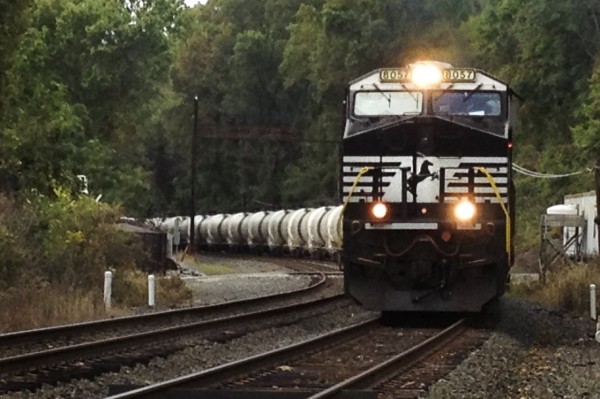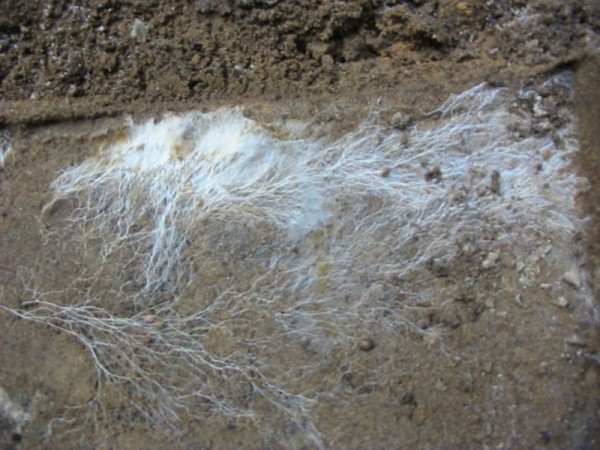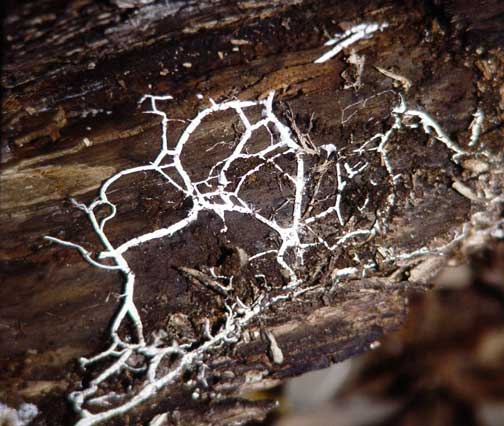The winner of the Buckminster Fuller Challenge was recently announced, and it’s a company called Ecovative. But before we get into how awesome it is and how it relates to saving the world, here’s a science lesson.
Have you ever heard of mycelium? Mycelium are white strands of fungi that spread out like roots in soil or on organic material.
Mycelium in soil
Mycelium growing on a decaying log
Imagine a thick slab of this mycelium — it would look kind of like a block of Styrofoam, right? It turns out it has very similar properties, too. But instead of being made from fossil fuels and sticking around forever in our landfills, it’s made from decomposable, renewable fungi and organic material usually considered a waste.
This is where Ecovative enters in. About 6 years ago, they realized that if they could grow mycelium in particular shapes it would be an ideal replacement for Styrofoam. What do they need in order to do this? Just “waste” biomass like agricultural residues (leftover cornstalks, etc.), cellulose sludge from paper mills, lobster shells and even textile wastes. These materials would ordinarily be thrown out and cost money to be landfilled.
Ecovative instead buys these wastes products from farms and businesses, feeding them to fungi. It’s a closed-loop system creating new value out of waste products. Ecovative has been able to make all sorts of things out of it, like packing/shipping materials, surfboards, and cups. They say the cost of their final products is cheaper than Styrofoam and other materials they replace, so hopefully we’ll be seeing Ecovative’s products everywhere soon.

Ecovative is using fungi to grow products we need using “waste” biomass bought from farms, paper mills, etc. A win-win for everyone and the planet! The guy carrying just one Ecovative product is obviously a slacker.
How does this tie into the saving the world and the Buckminster Fuller Challenge? The visionary architect, inventor, and systems theorist Buckminster Fuller (“Bucky”) said, “You never change things by fighting the existing reality. To change something, build a new model that makes the existing model obsolete.”
Ecovative is successful because they aren’t merely fighting against our wasteful consumerist culture and lack of sustainable materials. They are filling a niche for a new product that meets our needs in a sustainable way. They know if they can make a desirable product for a wide range of industries and consumers then it will gain a strong foothold in the market.
In summary, Bucky tells us that change happens when a new, better alternative comes about and not just by fighting the existing system. This insight makes me think of other environmental challenges we face.
There is significant effort directed against hydrofracking and new pipelines to carry oil from Canadian tar sands through the US. Tar sands are a less concentrated source of oil than conventional sources, so it takes a lot more energy and effort to extract and refine it. Thus it has a larger carbon footprint than than many other fossil fuels and is an energy-intensive and polluting process as well.
NPR recently reported that oil produced from Canadian tar sands (as well as from fracking in the US) is being shipped on trains because opposition to the Keystone XL pipeline has (so far) prevented its construction. According to this article, in 2008 about 9,500 train cars were used to ship crude oil to refineries in the US. In 2012, this had skyrocketed to 234,000 train cars. There are also safety concerns associated with train derailments and aging track infrastructure like the July 2013 derailment in Quebec that killed dozens of people.

“A train pulls oil tank units on its way to a refinery in Delaware. As U.S. oil production outpaces its pipeline capacity, more and more companies are looking to the railways to transport crude oil.”
Many people are standing up and saying they don’t want to expand new fossil fuel sources in our already warming climate. But how can activists, scientists, and other concerned people focus on solutions — on what to be for instead of only what to be against?
“But demand is the key, say most economists. If you can get American drivers to buy less gas — by raising fuel efficiency standards … you stand a much better chance of slowing production in the oil sands.”
The key is to change the system: to focus on alternatives to fossil fuels combined with energy and fuel efficiency. Some ways to do this are to promote local renewable energy, especially community-owned projects that keep more money and jobs local; advocate for investment, subsidies, and better policy for renewables; and to support the Union of Concerned Scientists’ Half the Oil Plan, a multi-faceted plan that will cut our oil use in half within just 20 years.
Here’s an example of the disparity in subsidies between fossil fuels and renewables.
“From 2002 to 2008, the U.S. government gave the mature fossil fuel industry more than $72 billion in subsidies while investments in the emerging renewable-energy industry totaled $12.2 billion.” [underlining emphasis mine]
How much could renewables grow with equivalent (or superior) support compared to fossil fuels?
Two of my favorite groups working on these issues are the Institute for Local Self-Reliance and the Union of Concerned Scientists. Check them out and read up on some of these issues. You can use their websites to quickly write letters to Congress, the President, and so forth. You could also bring up the idea of community-owned renewable energy with your own local officials and those running for local office.


